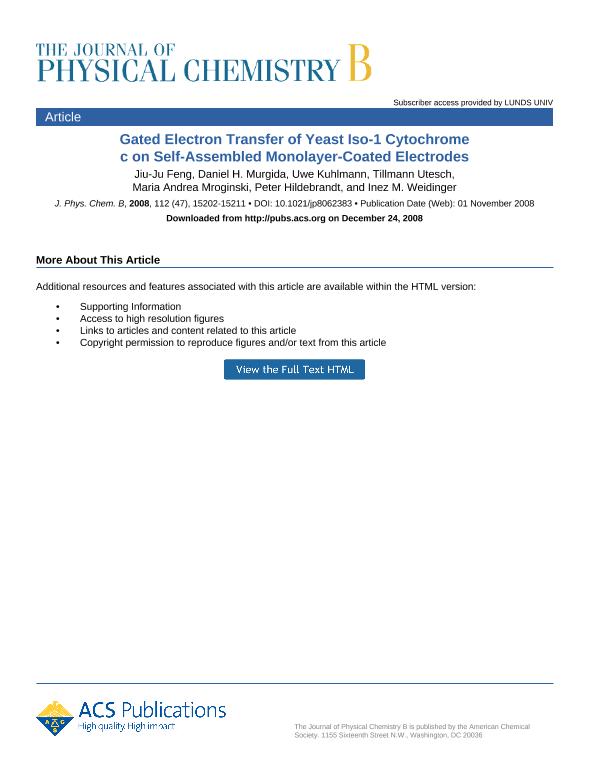Mostrar el registro sencillo del ítem
dc.contributor.author
Feng, Jiu-Ju

dc.contributor.author
Murgida, Daniel Horacio

dc.contributor.author
Kuhlmann, U.
dc.contributor.author
Utesch, T.
dc.contributor.author
Mroginski, M. A.
dc.contributor.author
Hildebrandt, P.
dc.contributor.author
Weidinger, I. M.
dc.date.available
2019-09-17T22:22:27Z
dc.date.issued
2008-11
dc.identifier.citation
Feng, Jiu-Ju; Murgida, Daniel Horacio; Kuhlmann, U.; Utesch, T.; Mroginski, M. A.; et al.; Gated electron transfer of Yeast Iso-1 cytochrome c on self-assembled monolayer-coated electrodes; American Chemical Society; Journal of Physical Chemistry B; 112; 47; 11-2008; 15202-15211
dc.identifier.issn
1089-5647
dc.identifier.uri
http://hdl.handle.net/11336/83795
dc.description.abstract
Iso-1 yeast cytochrome c (YCC) was adsorbed on Ag electrodes coated with self-assembled monolayers (SAMs) consisting either of 11-mercaptoundecanoic acid (MUA) or of 1:1 mixtures of MUA and either 11-mercaptoundecanol (MU) or 7-mercaptoheptanol (MH). The redox potentials and the apparent rate constants for the interfacial redox process as well as for the protein reorientation were determined by stationary surface-enhanced resonance Raman (SERR) and time-resolved SERR spectroscopy, respectively. For YCC immobilized on MUA and MUA/MU at pH 7.0 and 6.0, the negative shifts of the redox potentials with respect to that for the protein in solution can be rationalized in terms of the potential of the zero-charge determined by impedance measurements. The apparent electron transfer rate constants of YCC on MUA/MU and MU/MH at pH 6.0 were determined to be 8 and 18 s-1, respectively. A decrease of the relaxations constants by a factor of ca. 2 was found for pH 7.0, and a comparable low value was determined for a pure MUA even at pH 6.0. In each system, the rate constant for protein reorientation was found to be the same as that for the electron transfer, implying that protein reorientation is the rate limiting step for the interfacial redox process. This gating step is distinctly slower than that for horse heart cytochrome c (HHCC) observed previously under similar conditions (Murgida, D. H.; Hildebrandt, P. J. Am. Chem. Soc. 2001, 123, 4062-4068). The different rate constants of protein reorientation for both proteins and the variations of the rate constants for the different SAMs and pH are attributed to the electric field dependence of the free energy of activation which is assumed to be proportional to the product of the electric field strength and the molecular dipole moment of the protein. The latter quantity is determined by molecular dynamics simulations and electrostatic calculations to be more than 2 times larger for YCC than for HHCC. Moreover, the dipole moment vector and the heme plane constitute an angle of ca. 10 and 45° in YCC and HHCC, respectively. The different magnitudes and directions of the dipole moments as well as the different electric field strengths at the various SAM/protein interfaces allow for a qualitative description of the protein-, SAM-, and electrode-specific kinetics of the interfacial redox processes studied in this and previous works.
dc.format
application/pdf
dc.language.iso
eng
dc.publisher
American Chemical Society
dc.rights
info:eu-repo/semantics/openAccess
dc.rights.uri
https://creativecommons.org/licenses/by-nc-sa/2.5/ar/
dc.subject
Cytochrome
dc.subject
Electron Transfer
dc.subject
Tr-Serr
dc.subject
Sams
dc.subject.classification
Físico-Química, Ciencia de los Polímeros, Electroquímica

dc.subject.classification
Ciencias Químicas

dc.subject.classification
CIENCIAS NATURALES Y EXACTAS

dc.title
Gated electron transfer of Yeast Iso-1 cytochrome c on self-assembled monolayer-coated electrodes
dc.type
info:eu-repo/semantics/article
dc.type
info:ar-repo/semantics/artículo
dc.type
info:eu-repo/semantics/publishedVersion
dc.date.updated
2019-06-11T18:14:35Z
dc.identifier.eissn
1520-6106
dc.journal.volume
112
dc.journal.number
47
dc.journal.pagination
15202-15211
dc.journal.pais
Estados Unidos

dc.description.fil
Fil: Feng, Jiu-Ju. Technishe Universitat Berlin; Alemania
dc.description.fil
Fil: Murgida, Daniel Horacio. Consejo Nacional de Investigaciones Científicas y Técnicas. Oficina de Coordinación Administrativa Ciudad Universitaria. Instituto de Química, Física de los Materiales, Medioambiente y Energía. Universidad de Buenos Aires. Facultad de Ciencias Exactas y Naturales. Instituto de Química, Física de los Materiales, Medioambiente y Energía; Argentina. Universidad de Buenos Aires. Facultad de Ciencias Exactas y Naturales. Departamento de Química Inorgánica, Analítica y Química Física; Argentina
dc.description.fil
Fil: Kuhlmann, U.. Technishe Universitat Berlin; Alemania
dc.description.fil
Fil: Utesch, T.. Technishe Universitat Berlin; Alemania
dc.description.fil
Fil: Mroginski, M. A.. Technishe Universitat Berlin; Alemania
dc.description.fil
Fil: Hildebrandt, P.. Technishe Universitat Berlin; Alemania
dc.description.fil
Fil: Weidinger, I. M.. Technishe Universitat Berlin; Alemania
dc.journal.title
Journal of Physical Chemistry B

dc.relation.alternativeid
info:eu-repo/semantics/altIdentifier/url/https://pubs.acs.org/doi/full/10.1021/jp8062383
dc.relation.alternativeid
info:eu-repo/semantics/altIdentifier/doi/https://doi.org/10.1021/jp8062383
Archivos asociados
